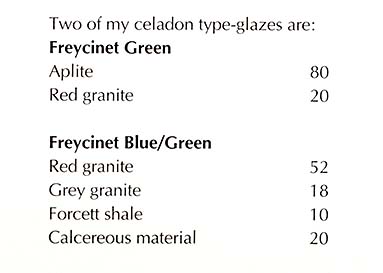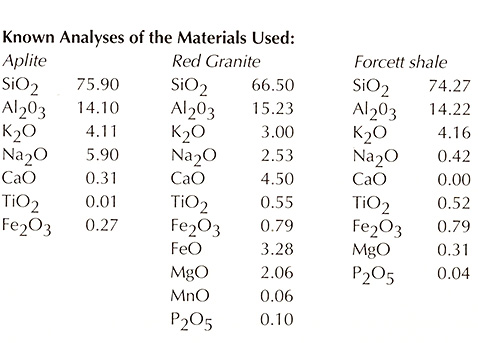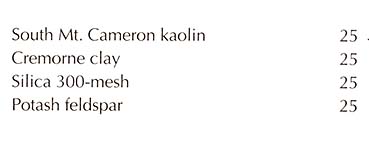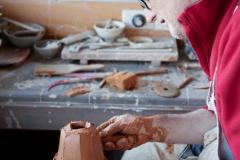Glazes from Local Raw Materials
I live in Tasmania, the southernmost state in Australia. For the last fifteen years, I have researched and tested Tasmanian raw materials with the aim of making my glazes entirely from the local materials that I have collected and processed.
In the late 1970s, two of Australia's leading potters, Les Blakebrough and Gwyn Hanssen-Pigott were living and working in Tasmania. Both had trained at the Sturt Pottery with Ivan McMeekin, who had in turn worked with Michael Cardew at Wenford Bridge Pottery. Both had by this time developed strong, individual work and maintained a commitment to the use of local clays and glaze materials fostered by McMeekin's passionate advocacy for the use of Australian raw materials.
Gwyn and John Pigott, along with enthusiastic Tasmanian amateur potters, collected, processed and tested many local materials, and I remain very grateful for this work which gave a sound basis for my own testing.
I was fortunate to become interested in pottery at a time when a strong materials-based aesthetic was seen as important to the development of an Australian style. Since then, the growth of the ceramic supply industry has meant that materials from throughout the world are now readily available. These materials have been purified through processing to give consistent responses for the sanitary ware and commercial tableware industries.
I have chosen to use local materials which produce less predictable results as an alternative to the manipulation of commercial materials processed for the requirements of the ceramics industry. I try to respond to the potentialities of each material revealed through the testing processes rather than trying to reproduce certain classical prototypes. Inevitably, because the materials used are similar to those used by traditional potters, my glazes share a common thread with classical stoneware glazes, with high-iron materials producing tenmoku and kaki-type of glazes, while low iron materials yield celadon and chun-type glazes.
The low iron materials that I use are granites and related igneous rocks (Michael Cardew's Pioneer Pottery has an opening chapter on geology for potters that provides a very useful starting point for developing an understanding of materials). The east coast of Tasmania and the Freycinet peninsula in particular has extensive deposits of red and grey granite, as well as much smaller deposits of aplite, a low iron, low titanium granitic rock, and these form the basis of many of my glazes. The red granite is deposited as granitic beach sand at 38 the base of dramatic granite mountains which are weathering continuously. Here nature has partly prepared the material with only ball milling required to reduce the sand to the fineness required for its use as a glaze material. The grey granite and aplite are in rock form and require calcining and then crushing before ball milling can proceed.
As well as the igneous rocks, a range of clays, a feldspathic shale, wood ash and other calcereous materials are prepared for use as glaze materials. This usually means wet mixing, then sieving through a 100-mesh sieve, although the wood ash may be put through a coarser sieve to give more variation of glazed surface.
Testing is initially done with material-only melt tests, and depending on those results triaxial blend tests are done with other materials that may increase the melt, alter the surface, or change the colour. Further line blend testing and small batch working tests may then be done. If chemical analyses of the raw materials are available, then test glaze composition often will be calculated using percentage analysis to give added information that sometimes speeds up the process of glaze development. Most testing, however, is done empirically and with increasing familiarity comes the ability to play hunches, and this is often of more value than any chemical analysis.
Firing of these glazes is done in a fibre-lined gas kiln to Orton cone 9, with reduction starting at 1050°C and continuing through the rest of the firing. I have found that firing these glazes to even slightly higher temperatures results in more gloss and less depth in the glaze surface. Often test results are different from expectations and it is important to see the potentiality rather than be disappointed in these circumstances. Usually it takes time to develop forms that provide a sensitive response for particular glazes. I try to use simple decorating techniques with these glazes - incising, fluting, and faceting- that allow changes in glaze depth to enhance surfaces. Often the glazes seem to call for restraint and the challenge of an unadorned form.

The Freycinet Green glaze being composed of only two rocks is difficult to suspend, but this can be assisted with an addition of vinegar, which allows the glaze to be applied by dipping very thickly in a single application. When fired, this glaze has a strong crazing pattern which is only fully revealed over several weeks after the firing. The glaze is easily over-fired and the development of forms with tripodal cut-away feet was a response to the fluid nature of the glaze.
The Freycinet Blue/Green is also very temperature-sensitive, giving a pale-green semi-opaque colour at cone 9, but developing a blue colour with increased transparency as the temperature increases. This glaze would seem to be in the transition range between celadon and chun type glazes.

Analysis of the grey granite (Adamalite) is not known but results from substitution tests with red granite suggest that it has higher levels of both calcium and iron than the red granite. The calcereous material consists of a nearby deposit of decomposed diatoms and can be used as a fairly direct replacement for whiting.
My clay bodies are prepared in the workshop from combinations of local clays wet-mixed with feldspar and silica. A range of bodies are prepared and the interaction between clay body and glaze is critical. The body used for these low-iron glazes is a porcellaneous body with the following recipe:

The South Mt. Cameron kaolin comes from an old tin mining area in northern Tasmania, and the Cremorne clay is a fine sedimentary clay which comes from the edge of a lagoon near the workshop.
I would like to encourage anyone interested in using local materials. Sources of information may include government departments dealing with mining or mineral resources and geology departments within universities. If published information is unavailable, then empirical testing, starting with basic melt tests, is a good beginning.
We live in an incredibly diverse world with our historical knowledge largely based on artifacts, particularly ceramics. The combination of materials, processes and culture has produced a rich source of inspiration, providing an everpresent challenge to me. The choice that I have made to concentrate on using local materials is stimulating and at times frustrating, but offers a way to nurture a sense and spirit of place in the work. I have sought through my choice of materials to give a regional focus to my work within a wider national and international context.

